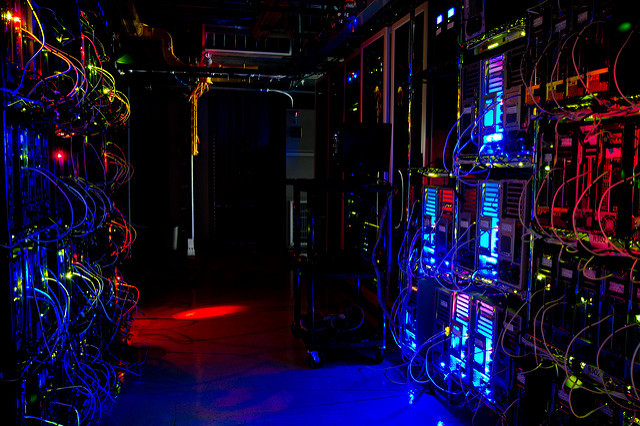What is the feature of underground data centers
At 1cloud, we are constantly improving the services of our IaaS provider and write a lot about this in a blog on Habré.
More recently, we briefly talked about what is behind the pictures on the Internet , using the example of the data center of imgix photo hosting.
Today we will continue this topic and talk about the features of underground data centers. / photo Dennis van Zuijlekom CC

Let's start with an analysis of the main advantages and disadvantages of this type of data center.
The first thing that comes to mind - non-triviality - many are afraid of the similar design of the data center - people imagine a deep mine or something in the spirit of a subway tunnel with trolleys. Of course, in reality everything is much more primitive and there is nothing to be afraid of.
From this myth, people derive a number of attendant things, such as the difficulty of choosing such a place underground, where a whole data center could be located. Here, everyone has their own idea of its potential size and occupied area, but in general there are not as many problems with accommodation as it might seem at first glance.
On the other hand, there is no need to engage in the construction of individual buildings. At the same time, the underground data center always has an advantage - protection against weather disasters (of course, taking into account all the necessary factors for water diversion and strengthening the arches).
In some cases, underground data centers are equipped with hybrid cooling systems or completely transfer them to water cooling, which in general can give a tangible increase in economic efficiency, and this should also affect the cost of services. / photo Atomic Taco CC

Many companies launching underground data centers do not spend time and money on drilling mines and strengthening underground vaults - they use former mines, and even better, those that already have archival facilities.
An example of this approach is Iron Mountain Data Center in Pittsburgh. In addition, water cooling is used here - water is taken directly from the underground lake.
An almost complete copy is the Green Mountain data center in Norway. It occupies former military depots - this is a fairly common approach that Europeans love. Among the customers of the data center is one of the largest financial institutions in Norway - DNB Bank.
Another fan of military installations - the owners of the server farm in the “Swiss Fort Knox” (Swiss Fort Knox). In this case, the bunkers left over from the Cold War are involved.
Of course, these guys have no problems in demonstrating the disaster tolerance potential of the data center. For cooling - water from a nearby underground lake.
PS A few more materials on the topic from our blog:
More recently, we briefly talked about what is behind the pictures on the Internet , using the example of the data center of imgix photo hosting.
Today we will continue this topic and talk about the features of underground data centers. / photo Dennis van Zuijlekom CC

Myths about the pros and cons
Let's start with an analysis of the main advantages and disadvantages of this type of data center.
The first thing that comes to mind - non-triviality - many are afraid of the similar design of the data center - people imagine a deep mine or something in the spirit of a subway tunnel with trolleys. Of course, in reality everything is much more primitive and there is nothing to be afraid of.
From this myth, people derive a number of attendant things, such as the difficulty of choosing such a place underground, where a whole data center could be located. Here, everyone has their own idea of its potential size and occupied area, but in general there are not as many problems with accommodation as it might seem at first glance.
On the other hand, there is no need to engage in the construction of individual buildings. At the same time, the underground data center always has an advantage - protection against weather disasters (of course, taking into account all the necessary factors for water diversion and strengthening the arches).
In some cases, underground data centers are equipped with hybrid cooling systems or completely transfer them to water cooling, which in general can give a tangible increase in economic efficiency, and this should also affect the cost of services. / photo Atomic Taco CC

Examples
Many companies launching underground data centers do not spend time and money on drilling mines and strengthening underground vaults - they use former mines, and even better, those that already have archival facilities.
An example of this approach is Iron Mountain Data Center in Pittsburgh. In addition, water cooling is used here - water is taken directly from the underground lake.
An almost complete copy is the Green Mountain data center in Norway. It occupies former military depots - this is a fairly common approach that Europeans love. Among the customers of the data center is one of the largest financial institutions in Norway - DNB Bank.
Another fan of military installations - the owners of the server farm in the “Swiss Fort Knox” (Swiss Fort Knox). In this case, the bunkers left over from the Cold War are involved.
Of course, these guys have no problems in demonstrating the disaster tolerance potential of the data center. For cooling - water from a nearby underground lake.
PS A few more materials on the topic from our blog:
- Myths about cloud technology. Part 1
- Myths about cloud technology. Part 2
- Myths about cloud technology. Part 3: talking about iron
- How to make virtual infrastructure more accessible
- Virtual IT Infrastructure: Pros and Cons
- How to create a virtual infrastructure provider: 1cloud experience
- In simple words: Understanding cloud services
